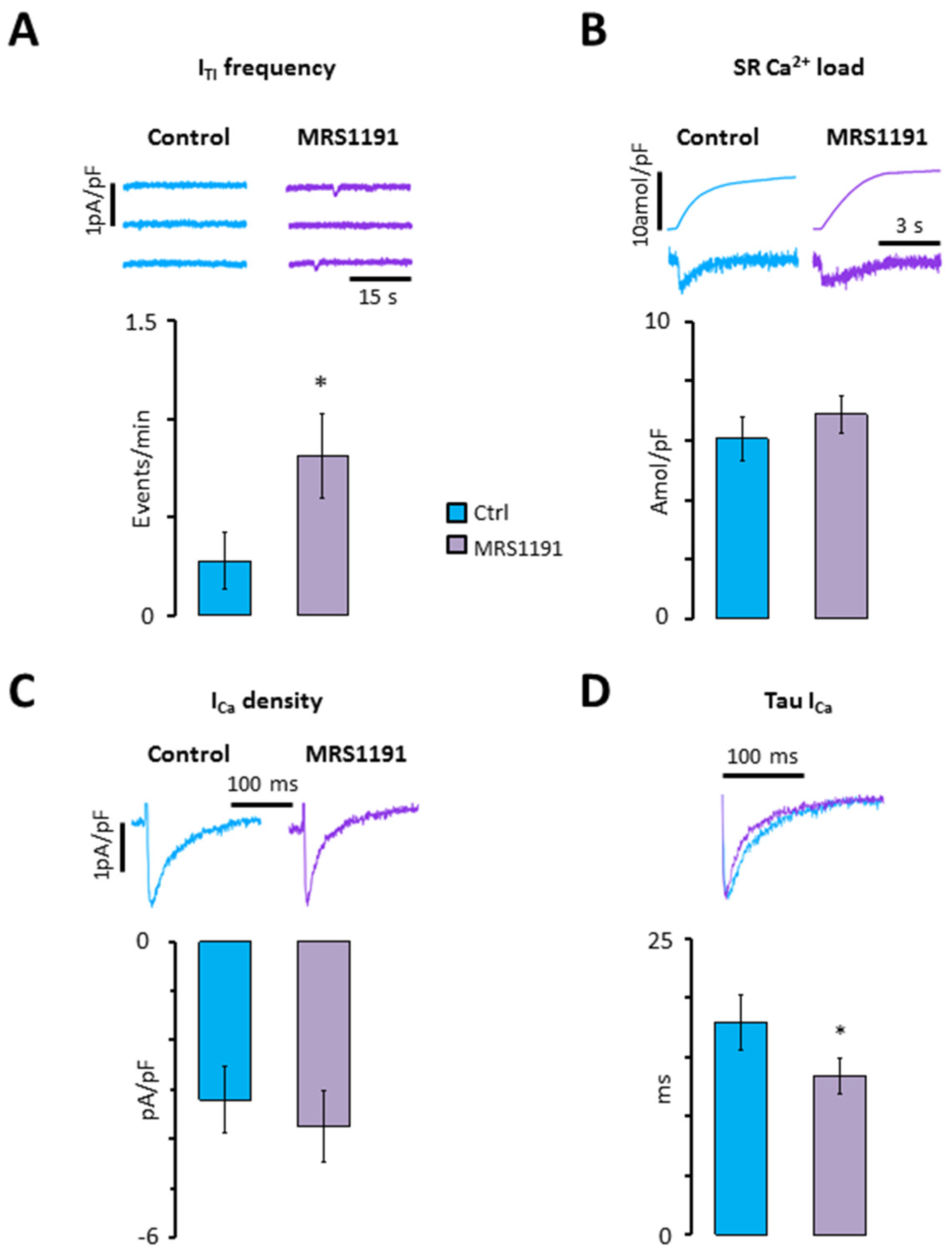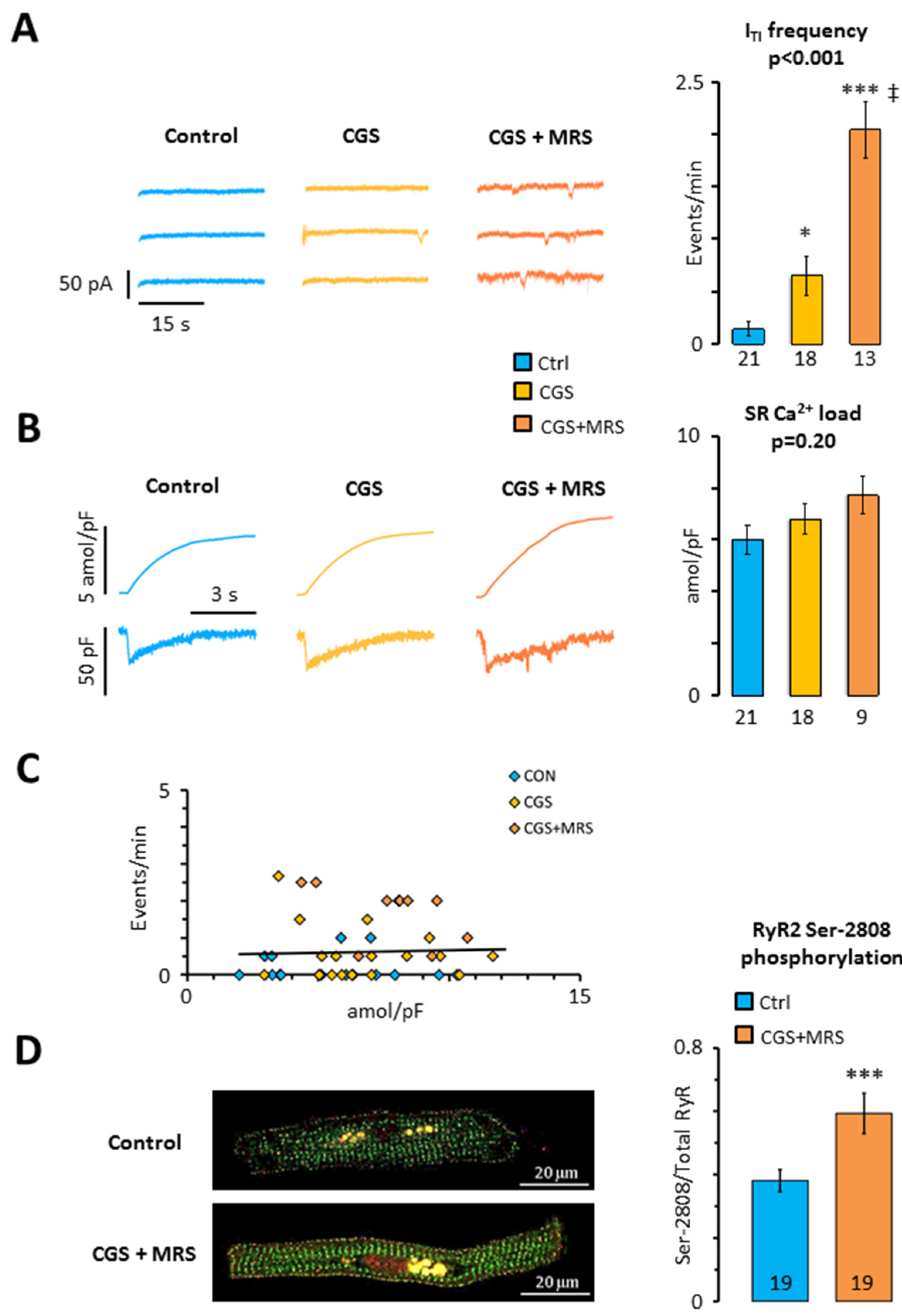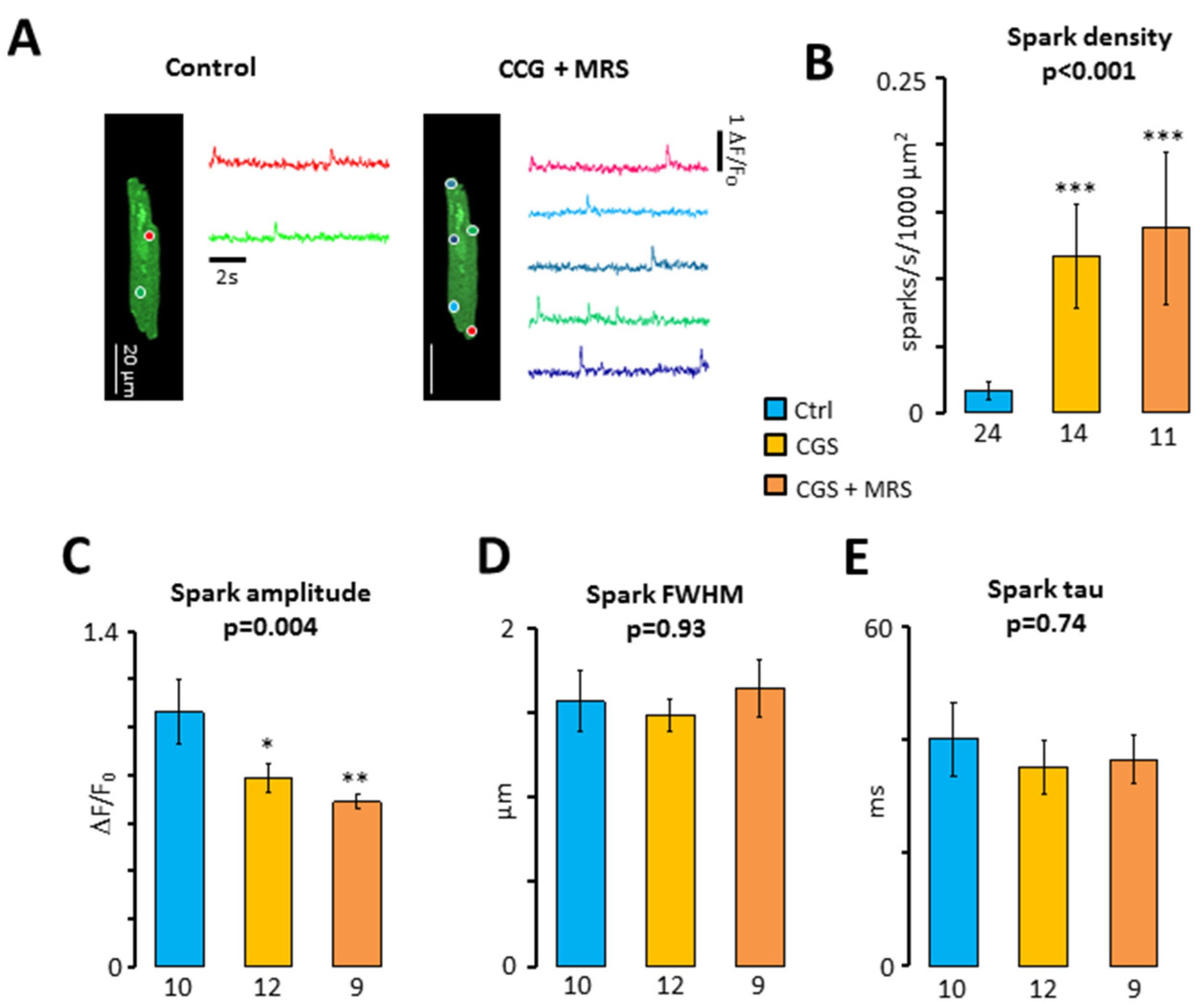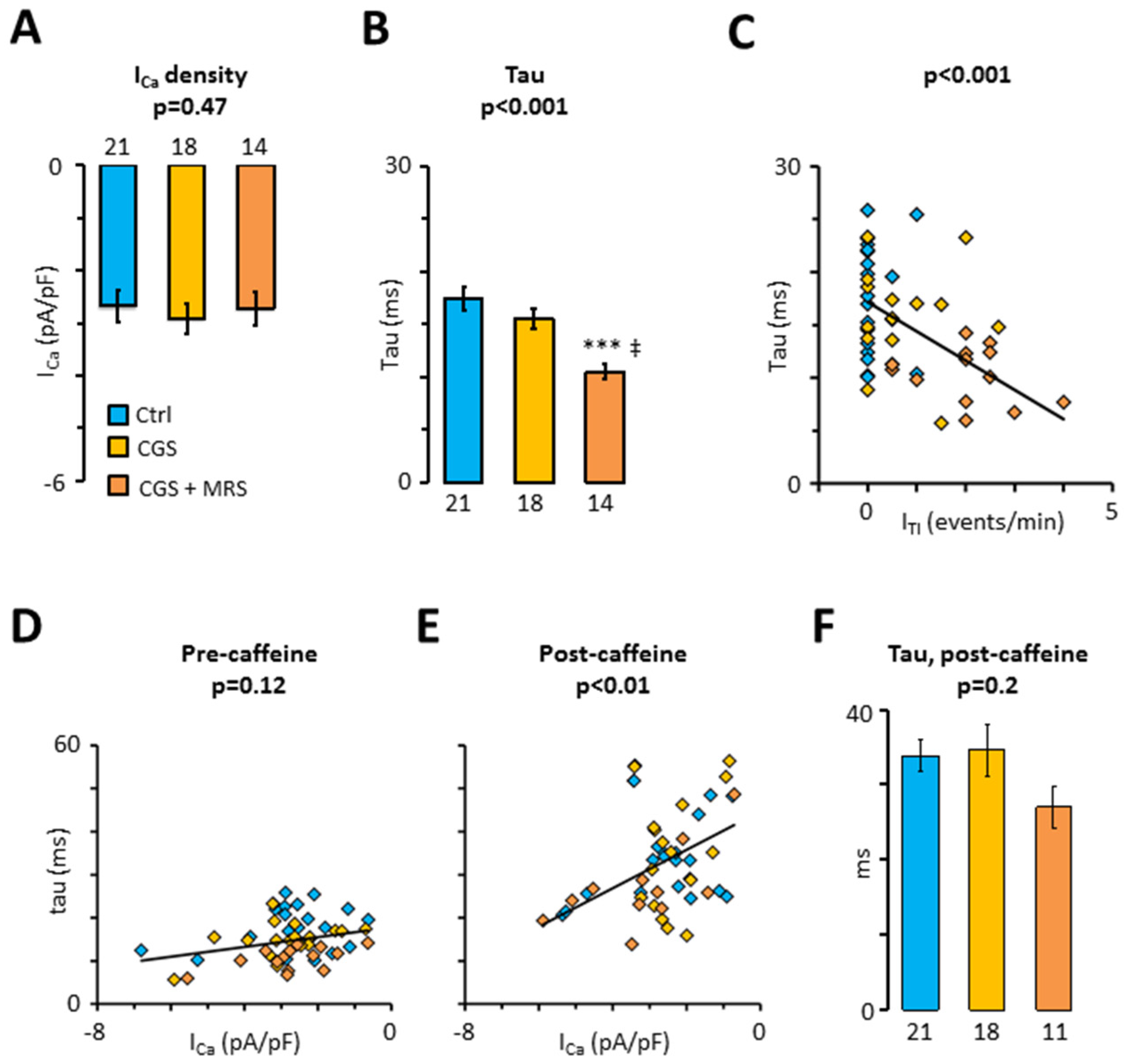Expression and Impact of Adenosine A3 Receptors on Calcium Homeostasis in Human Right Atrium
Abstract
1. Introduction
2. Results
2.1. Adenosine A3R Expression
2.2. Impact of Adenosine A3Rs on Calcium Homeostasis at Baseline
2.3. Impact of Crosstalk between A3R and A2AR on Spontaneous Calcium Release
2.4. Impact of Crosstalk between A3R and A2AR on L-type Calcium Current
3. Discussion
3.1. Main Findings
3.2. Impact of the A3R on Calcium Homeostasis at Baseline
3.3. Impact of Crosstalk between A3Rs and A2ARs on Calcium Homeostasis
3.4. Study Limitations
3.5. Clinical Implications and Conclusion
4. Materials and Methods
4.1. Myocyte Isolation
4.2. Quantitative Real-Time PCR
4.3. Patch-Clamp Technique
4.4. Immunofluorescent Labelling
4.5. Confocal Imaging
4.6. Data Analysis
Author Contributions
Funding
Institutional Review Board Statement
Informed Consent Statement
Data Availability Statement
Acknowledgments
Conflicts of Interest
References
- Vest, J.A.; Wehrens, X.H.; Reiken, S.R.; Lehnart, S.E.; Dobrev, D.; Chandra, P.; Danilo, P.; Ravens, U.; Rosen, M.R.; Marks, A.R. Defective Cardiac Ryanodine Receptor Regulation during Atrial Fibrillation. Circulation 2005, 111, 2025–2032. [Google Scholar] [CrossRef]
- Mattiazzi, A.; Hove-Madsen, L.; Bers, D.M. Protein Kinase Inhibitors Reduce SR Ca Transport in Permeabilized Cardiac Myocytes. Am. J. Physiol. Circ. Physiol. 1994, 267, H812–H820. [Google Scholar] [CrossRef] [PubMed]
- Hove-Madsen, L.; Méry, P.-F.; Jurevičius, J.; Skeberdis, A.V.; Fischmeister, R. Regulation of Myocardial Calcium Channels by Cyclic AMP Metabolism. Basic Res. Cardiol. 1996, 91, 1–8. [Google Scholar] [CrossRef]
- Fischmeister, R.; Castro, L.R.V.; Abi-Gerges, A.; Rochais, F.; Jurevičius, J.; Leroy, J.; Vandecasteele, G. Compartmentation of Cyclic Nucleotide Signaling in the Heart: The Role of Cyclic Nucleotide Phosphodiesterases. Circ. Res. 2006, 99, 816–828. [Google Scholar] [CrossRef] [PubMed]
- Belardinelli, L.; Shryock, J.C.; Song, Y.; Wang, D.; Srinivas, M. Ionic Basis of the Electrophysiological Actions of Adenosine on Cardiomyocytes. FASEB J. 1995, 9, 359–365. [Google Scholar] [CrossRef] [PubMed]
- Dennis, D.M.; Raatikainen, M.J.P.; Martens, J.R.; Belardinelli, L. Modulation of Atrioventricular Nodal Function by Metabolic and Allosteric Regulators of Endogenous Adenosine in Guinea Pig Heart. Circulation 1996, 94, 2551–2559. [Google Scholar] [CrossRef] [PubMed]
- Atienza, F.; Almendral, J.; Moreno, J.; Vaidyanathan, R.; Talkachou, A.; Kalifa, J.; Arenal, A.; Villacastín, J.P.; Torrecilla, E.G.; Sánchez, A.; et al. Activation of Inward Rectifier Potassium Channels Accelerates Atrial Fibrillation in Humans: Evidence for a Reentrant Mechanism. Circulation 2006, 114, 2434–2442. [Google Scholar] [CrossRef]
- Li, N.; Csepe, T.A.; Hansen, B.J.; Sul, L.V.; Kalyanasundaram, A.; Zakharkin, S.O.; Zhao, J.; Guha, A.; Van Wagoner, D.R.; Kilic, A.; et al. Adenosine-Induced Atrial Fibrillation. Circulation 2016, 134, 486–498. [Google Scholar] [CrossRef]
- Wan, T.C.; Tampo, A.; Kwok, W.M.; Auchampach, J.A. Ability of CP-532,903 to Protect Mouse Hearts from Ischemia/Reperfusion Injury Is Dependent on Expression of A 3 Adenosine Receptors in Cardiomyoyctes. Biochem. Pharmacol. 2019, 163, 21–31. [Google Scholar] [CrossRef]
- Stambaugh, K.; Elliott, G.T.; Jacobson, K.A.; Liang, B.T. Additive Effects of Late Preconditioning Produced by Monophosphoryl Lipid A and the Early Preconditioning Mediated by Adenosine Receptors and K(ATP) Channel. Circulation 1999, 99, 3300–3307. [Google Scholar] [CrossRef]
- Carr, C.S.; Hill, R.J.; Masamune, H.; Kennedy, S.P.; Knight, D.R.; Tracey, W.R.; Yellon, D.M. Evidence for a Role for Both the Adenosine A1 and A3 Receptors in Protection of Isolated Human Atrial Muscle against Simulated Ischaemia. Cardiovasc. Res. 1997, 36, 52–59. [Google Scholar] [CrossRef]
- Hove-Madsen, L.; Prat-Vidal, C.; Llach, A.; Ciruela, F.; Casadó, V.; Lluis, C.; Bayes-Genis, A.; Cinca, J.; Franco, R. Adenosine A2A Receptors Are Expressed in Human Atrial Myocytes and Modulate Spontaneous Sarcoplasmic Reticulum Calcium Release. Cardiovasc. Res. 2006, 72, 292–302. [Google Scholar] [CrossRef]
- Llach, A.; Molina, C.E.; Prat-Vidal, C.; Fernandes, J.; Casado, V.; Ciruela, F.; Lluis, C.; Franco, R.; Cinca, J.; Hove-Madsen, L. Abnormal Calcium Handling in Atrial Fibrillation Is Linked to Up-Regulation of Adenosine A2A Receptors. Eur. Heart J. 2011, 32, 721–729. [Google Scholar] [CrossRef]
- Molina, C.E.; Llach, A.; Herraiz-Martínez, A.; Tarifa, C.; Barriga, M.; Wiegerinck, R.F.; Fernandes, J.; Cabello, N.; Vallmitjana, A.; Benitéz, R.; et al. Prevention of Adenosine A2A Receptor Activation Diminishes Beat-to-Beat Alternation in Human Atrial Myocytes. Basic Res. Cardiol. 2016, 111, 1–15. [Google Scholar] [CrossRef]
- Gao, Z.G.; Blaustein, J.B.; Gross, A.S.; Melman, N.; Jacobson, K.A. N6-Substituted Adenosine Derivatives: Selectivity, Efficacy, and Species Differences at A3 Adenosine Receptors. Biochem. Pharmacol. 2003, 65, 1675–1684. [Google Scholar] [CrossRef] [PubMed]
- Langlois, M.; Fischmeister, R. 5-HT4 Receptor Ligands: Applications and New Prospects. ChemInform 2003, 34, 319–344. [Google Scholar] [CrossRef]
- Ferré, S.; Ciruela, F.; Dessauer, C.W.; González-Maeso, J.; Hébert, T.E.; Jockers, R.; Logothetis, D.E.; Pardo, L. G Protein-Coupled Receptor-Effector Macromolecular Membrane Assemblies (GEMMAs). Pharmacol. Ther. 2022, 231, 107977. [Google Scholar] [CrossRef]
- Nolla-Colomer, C.; Casabella-Ramon, S.; Jimenez-Sabado, V.; Vallmitjana, A.; Tarifa, C.; Herraiz-Martínez, A.; Llach, A.; Tauron, M.; Montiel, J.; Cinca, J.; et al. Β2-Adrenergic Stimulation Potentiates Spontaneous Calcium Release By Increasing Signal Mass and Co-Activation of Ryanodine Receptor Clusters. Acta Physiol. 2021, 234, 1–17. [Google Scholar] [CrossRef] [PubMed]
- Liang, B.T.; Jacobson, K.A. A Physiological Role of the Adenosine A3 Receptor: Sustained Cardioprotection. Proc. Natl. Acad. Sci. USA 1998, 95, 6995–6999. [Google Scholar] [CrossRef] [PubMed]
- Voigt, N.; Li, N.; Wang, Q.; Wang, W.; Trafford, A.W.; Abu-Taha, I.; Sun, Q.; Wieland, T.; Ravens, U.; Nattel, S.; et al. Enhanced Sarcoplasmic Reticulum Ca2+-Leak and Increased Na+-Ca2+ Exchanger Function Underlie Delayed Afterdepolarizations in Patients with Chronic Atrial Fibrillation. Circulation 2012, 125, 2059–2070. [Google Scholar] [CrossRef]
- Rivet-Bastide, M.; Vandecasteele, G.; Hatem, S.; Verde, I.; Bénardeau, A.; Mercadier, J.J.; Fischmeister, R. CGMP-Stimulated Cyclic Nucleotide Phosphodiesterase Regulates the Basal Calcium Current in Human Atrial Myocytes. J. Clin. Invest. 1997, 99, 2710–2718. [Google Scholar] [CrossRef]
- Molina, C.E.; Leroy, J.; Richter, W.; Xie, M.; Scheitrum, C.; Lee, I.O.; Maack, C.; Rucker-Martin, C.; Donzeau-Gouge, P.; Verde, I.; et al. Cyclic Adenosine Monophosphate Phosphodiesterase Type 4 Protects against Atrial Arrhythmias. J. Am. Coll. Cardiol. 2012, 59, 2182–2190. [Google Scholar] [CrossRef] [PubMed]
- Jiménez-Sábado, V.; Casabella-Ramón, S.; Llach, A.; Gich, I.; Casellas, S.; Ciruela, F.; Chen, S.R.W.; Guerra, J.M.; Ginel, A.; Benítez, R.; et al. Beta-Blocker Treatment of Patients with Atrial Fibrillation Attenuates Spontaneous Calcium Release-Induced Electrical Activity. Biomed. Pharmacother. 2023, 158, 114169. [Google Scholar] [CrossRef] [PubMed]
- Jacobson, K.A.; Tosh, D.K.; Jain, S.; Gao, Z.G. Historical and Current Adenosine Receptor Agonists in Preclinical and Clinical Development. Front. Cell. Neurosci. 2019, 13, 1–17. [Google Scholar] [CrossRef] [PubMed]
- Chandrasekera, P.C.; Wan, T.C.; Gizewski, E.T.; Auchampach, J.A.; Lasley, R.D. Adenosine A1 Receptors Heterodimerize with Β1- and Β2-Adrenergic Receptors Creating Novel Receptor Complexes with Altered G Protein Coupling and Signaling. Cell. Signal. 2013, 25, 736–742. [Google Scholar] [CrossRef]
- Ladera, C.; Godino, M.D.C.; Martín, R.; Luján, R.; Shigemoto, R.; Ciruela, F.; Torres, M.; Sánchez-Prieto, J. The Coexistence of Multiple Receptors in a Single Nerve Terminal Provides Evidence for Pre-Synaptic Integration. J. Neurochem. 2007, 103, 2314–2326. [Google Scholar] [CrossRef]
- Dragic, M.; Stekic, A.; Zeljkovic, M.; Zaric Kontic, M.; Mihajlovic, K.; Adzic, M.; Grkovic, I.; Nedeljkovic, N. Altered Topographic Distribution and Enhanced Neuronal Expression of Adenosine-Metabolizing Enzymes in Rat Hippocampus and Cortex from Early to Late Adulthood. Neurochem. Res. 2022, 47, 1637–1650. [Google Scholar] [CrossRef]
- Herraiz-Martínez, A.; Álvarez-García, J.; Llach, A.; Molina, C.E.; Fernandes, J.; Ferrero-Gregori, A.; Rodríguez, C.; Vallmitjana, A.; Benítez, R.; Padró, J.M.; et al. Ageing Is Associated with Deterioration of Calcium Homeostasis in Isolated Human Right Atrial Myocytes. Cardiovasc. Res. 2015, 106, 76–86. [Google Scholar] [CrossRef]
- Herraiz-Martínez, A.; Tarifa, C.; Jiménez-Sábado, V.; Llach, A.; Godoy-Marín, H.; Colino-Lage, H.; Nolla-Colomer, C.; Casabella-Ramon, S.; Izquierdo-Castro, P.; Benítez, I.; et al. Influence of Sex on Intracellular Calcium Homoeostasis in Patients with Atrial Fibrillation. Cardiovasc. Res. 2022, 118, 1033–1045. [Google Scholar] [CrossRef]
- Godoy-Marín, H.; Duroux, R.; Jacobson, K.A.; Soler, C.; Colino-Lage, H.; Jiménez-Sábado, V.; Montiel, J.; Hove-Madsen, L.; Ciruela, F. Adenosine A2A Receptors Are Upregulated in Peripheral Blood Mononuclear Cells from Atrial Fibrillation Patients. Int. J. Mol. Sci. 2021, 22, 3467. [Google Scholar] [CrossRef]
- Bertolet, B.D.; Hill, J.A.; Kerensky, R.A.; Belardinelli, L. Myocardial Infarction Related Atrial Fibrillation: Role of Endogenous Adenosine. Heart 1997, 78, 88–90. [Google Scholar] [CrossRef] [PubMed]
- Herraiz-Martínez, A.; Llach, A.; Tarifa, C.; Gandía, J.; Jiménez-Sabado, V.; Lozano-Velasco, E.; Serra, S.A.; Vallmitjana, A.; Vázquez Ruiz De Castroviejo, E.; Benítez, R.; et al. The 4q25 Variant Rs13143308T Links Risk of Atrial Fibrillation to Defective Calcium Homoeostasis. Cardiovasc. Res. 2019, 115, 578–589. [Google Scholar] [CrossRef] [PubMed]
- Tarifa, C.; Vallmitjana, A.; Jiménez-Sábado, V.; Marchena, M.; Llach, A.; Herraiz-Martínez, A.; Godoy-Marín, H.; Nolla-Colomer, C.; Ginel, A.; Viñolas, X.; et al. The Spatial Distribution of Calcium Sparks Determines Their Ability to Induce Afterdepolarizations in Human Atrial Myocytes. JACC Basic Transl. Sci. 2022, 8, 1–15. [Google Scholar] [CrossRef] [PubMed]





| (53 Patients) | ||
|---|---|---|
| Age, Years | 67.0 [65.0; 69.0] | |
| Sex (Female/Male) | 13/40 (24.5%/75.5%) | |
| Echocardiography | LAD index | 2.38 [2.26; 2.5] |
| LVEF, % | 55.0 [53.0; 57.0] | |
| Cardiovascular Risk Factors | No smoking | 22 (41.5%) |
| Smoking | 20 (37.7%) | |
| Ex smoking | 11 (20.8%) | |
| Hypertension | 36 (67.9%) | |
| Diabetes | 13 (24.5%) | |
| Dyslipidemia | 33 (62.3%) | |
| Surgical Treatment | AVR | 19 (35.8%) |
| MVR | 5 (9.4%) | |
| CABG | 31 (58.5%) | |
| Pharmacological Treatment | ACE inhibitor | 22 (41.5%) |
| Diuretics | 20 (37,7%) | |
| ARB | 13 (24.5%) | |
| Calcium antagonists | 23 (43.4%) | |
| Nitrates | 13 (24.5%) | |
| β-blockers | 26 (49.0%) | |
| Acetylsalicylic acid | 26 (49.0%) | |
| Statins | 34 (64.1%) | |
| More than one treatment | 49 (92.5%) |
| Frequencies | Control | CGS | CGS + MRS |
|---|---|---|---|
| Sparks/s/1000 µm2 | 0.017 ± 0.006 | 0.12 ± 0.04 *** | 0.14 ± 0.06 ** |
| Spark sites/1000 µm2 | 1.10 ± 0.42 | 6.18 ± 1.79 *** | 3.51 ± 1.22 * |
| Sparks/site/s | 0.018 ± 0.006 | 0.018 ± 0.003 | 0.031 ± 0.008 |
| Properties | |||
| Amplitude (∆F/F0) | 1.06 ± 0.13 | 0.79 ± 0.06 * | 0.69 ± 0.03 ** |
| Tau (ms) | 40.0 ± 6.6 | 35.2 ± 4.7 | 36.4 ± 4.3 |
| FDHM (ms) | 60.1 ± 8.3 | 60.2 ± 4.7 | 66.5 ± 5.2 |
| FWHM (µm) | 1.56 ± 0.18 | 1.49 ± 0.01 | 1.64 ± 0.16 |
Disclaimer/Publisher’s Note: The statements, opinions and data contained in all publications are solely those of the individual author(s) and contributor(s) and not of MDPI and/or the editor(s). MDPI and/or the editor(s) disclaim responsibility for any injury to people or property resulting from any ideas, methods, instructions or products referred to in the content. |
© 2023 by the authors. Licensee MDPI, Basel, Switzerland. This article is an open access article distributed under the terms and conditions of the Creative Commons Attribution (CC BY) license (https://creativecommons.org/licenses/by/4.0/).
Share and Cite
Tarifa, C.; Jiménez-Sábado, V.; Franco, R.; Montiel, J.; Guerra, J.; Ciruela, F.; Hove-Madsen, L. Expression and Impact of Adenosine A3 Receptors on Calcium Homeostasis in Human Right Atrium. Int. J. Mol. Sci. 2023, 24, 4404. https://doi.org/10.3390/ijms24054404
Tarifa C, Jiménez-Sábado V, Franco R, Montiel J, Guerra J, Ciruela F, Hove-Madsen L. Expression and Impact of Adenosine A3 Receptors on Calcium Homeostasis in Human Right Atrium. International Journal of Molecular Sciences. 2023; 24(5):4404. https://doi.org/10.3390/ijms24054404
Chicago/Turabian StyleTarifa, Carmen, Verónica Jiménez-Sábado, Rafael Franco, José Montiel, José Guerra, Francisco Ciruela, and Leif Hove-Madsen. 2023. "Expression and Impact of Adenosine A3 Receptors on Calcium Homeostasis in Human Right Atrium" International Journal of Molecular Sciences 24, no. 5: 4404. https://doi.org/10.3390/ijms24054404
APA StyleTarifa, C., Jiménez-Sábado, V., Franco, R., Montiel, J., Guerra, J., Ciruela, F., & Hove-Madsen, L. (2023). Expression and Impact of Adenosine A3 Receptors on Calcium Homeostasis in Human Right Atrium. International Journal of Molecular Sciences, 24(5), 4404. https://doi.org/10.3390/ijms24054404






